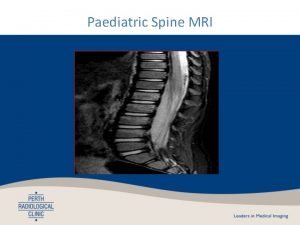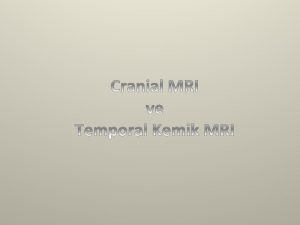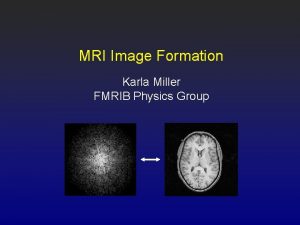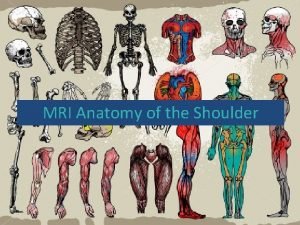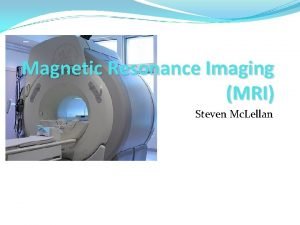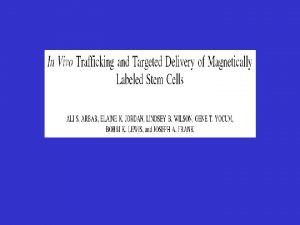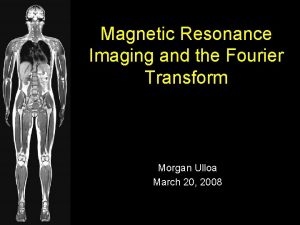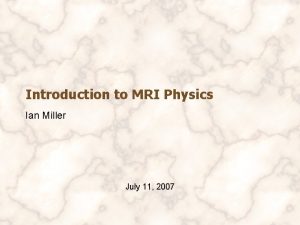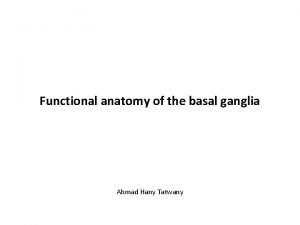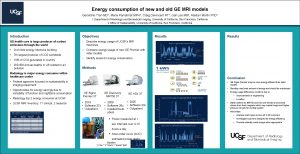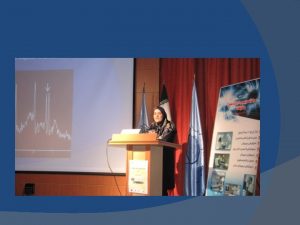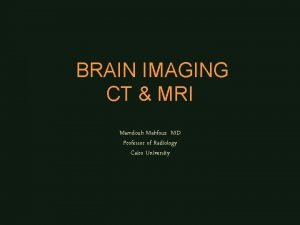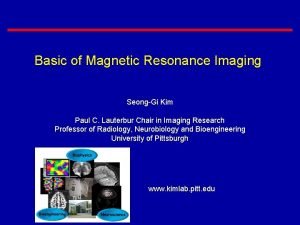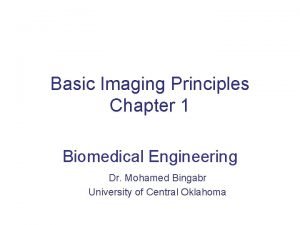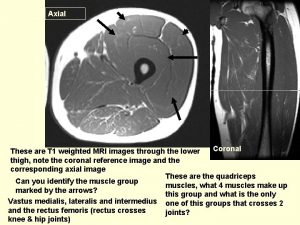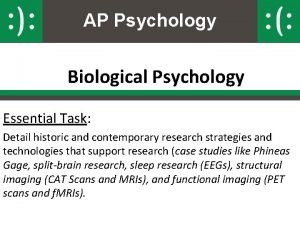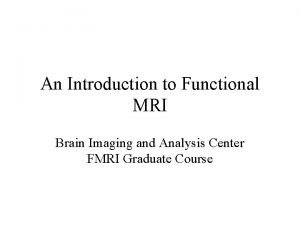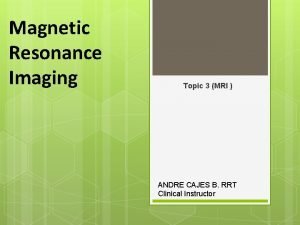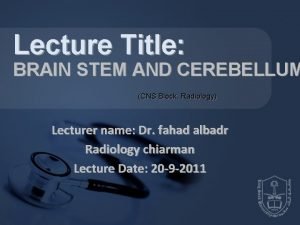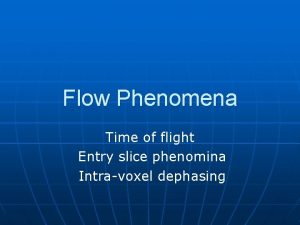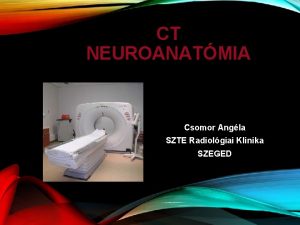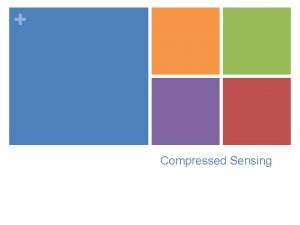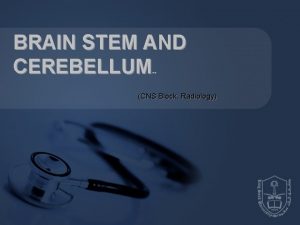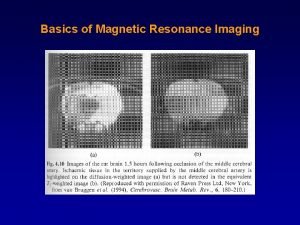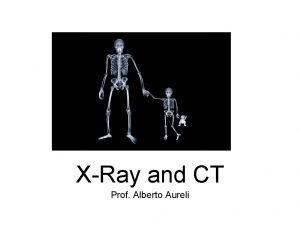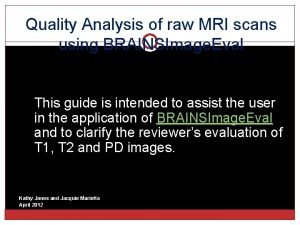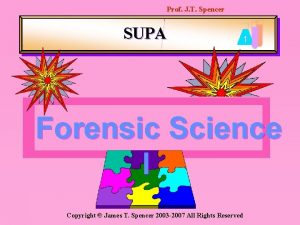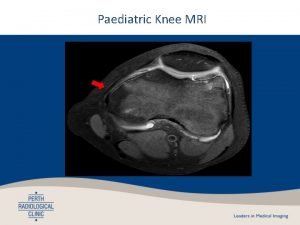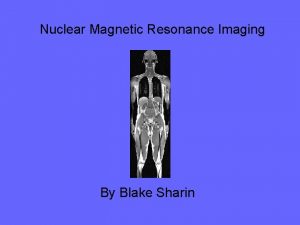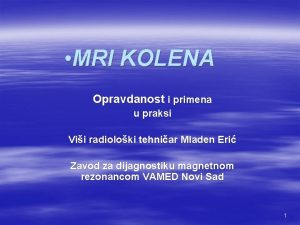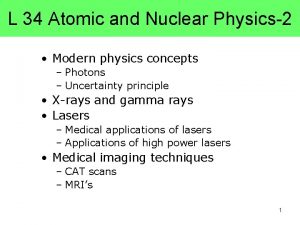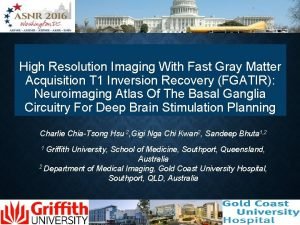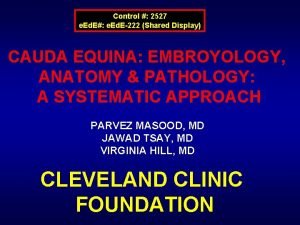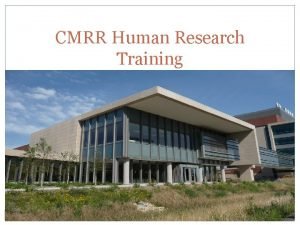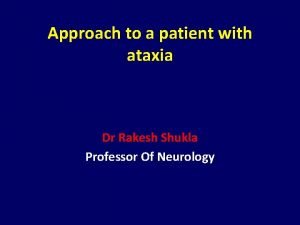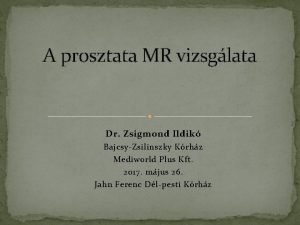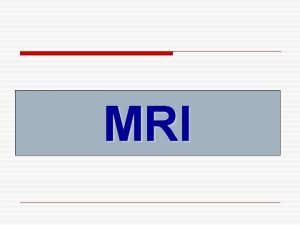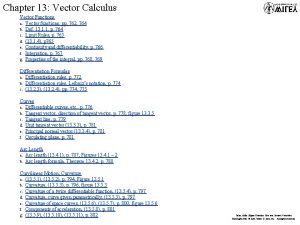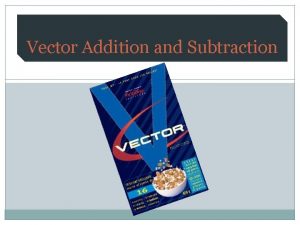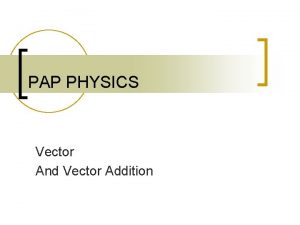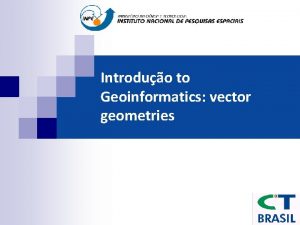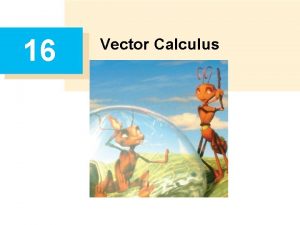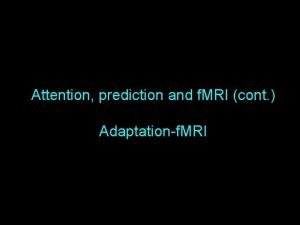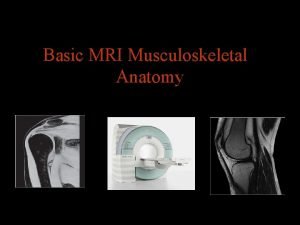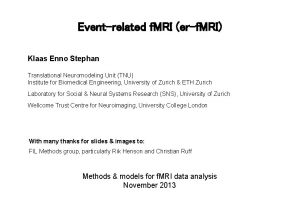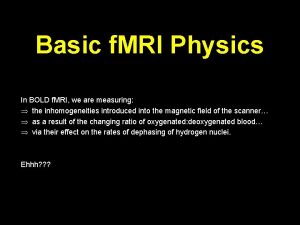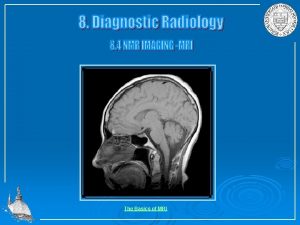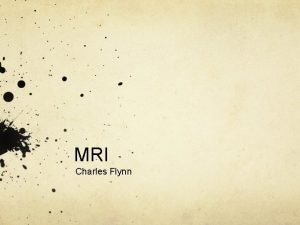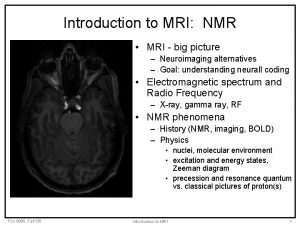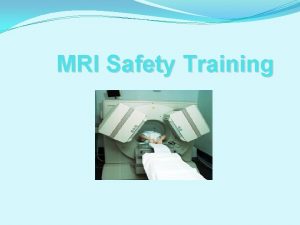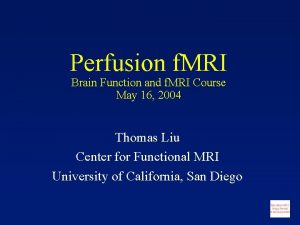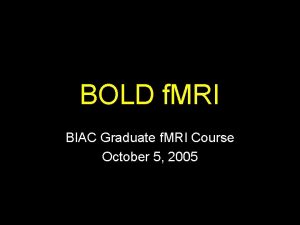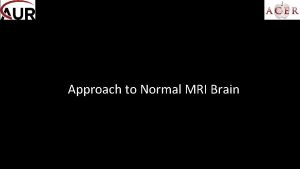MRI Vector Review z x y Vector Review













































- Slides: 45

MRI

Vector Review z x y

Vector Review (2) The Dot Product (a scalar) The Cross Product (a vector) (a scalar)

MR: Classical Description: Magnetic Moments NMR is exhibited in atoms with odd # of protons or neutrons. Spin angular momentum = Intuitively current, but nuclear spin operator in quantum mechanics Planck’s constant / 2 Spin angular momentum creates a dipole magnetic moment = gyromagnetic ratio : the ratio of the dipole moment to angular momentum Which atoms have this phenomenon? 1 H - abundant, largest signal 31 P 23 Na Model proton as a ring of current.

MR: Classical Description: Magnetic Fields How do we create and detect these moments? Magnetic Fields used in MR: 1) Static main field Bo 2) Radio frequency (RF) field B 1 3) Gradient fields Gx, Gy, Gz

MR: Classical Description: Magnetic Fields: Bo 1) Static main field Bo without Bo, spins are randomly oriented. macroscopically, with Bo, net magnetization a) spins align w/ Bo (polarization) b) spins exhibit precessional behavior - a resonance phenomena

Reference Frame y x z

MR: Energy of Magnetic Moment Alignment Convention: x Bo z z: longitudinal x, y: transverse y At equilibrium, Energy of Magnetic Moment in is equal to the dot product quantum mechanics - quantized states

MR: Energy states of 1 H Energy of Magnetic Moment in Hydrogen has two quantized currents, Bo field creates 2 energy states for Hydrogen where energy separation resonance frequency fo

MR: Nuclei spin states There are two populations of nuclei: n+ - called parallel n- - called anti parallel higher energy n- lower energy n+ Which state will nuclei tend to go to? For B= 1. 0 T Boltzman distribution: Slightly more will end up in the lower energy state. We call the net difference “aligned spins”. Only a net of 7 in 2*106 protons are aligned for H+ at 1. 0 Tesla. (consider 1 million +3 in parallel and 1 million -3 anti-parallel. But. . .

There is a lot of a water!!! • 18 g of water is approximately 18 ml and has approximately 2 moles of hydrogen protons • Consider the protons in 1 mm x 1 mm cube. • 2*6. 62*1023*1/1000*1/18 = 7. 73 x 1019 protons/mm 3 • If we have 7 excesses protons per 2 million protons, we get. 25 million billion protons per cubic millimeter!!!!

Magnetic Resonance: Spins We refer to these nuclei as spins. At equilibrium, - more interesting What if was not parallel to Bo? We return to classical physics. . . - view each spin as a magnetic dipole (a tiny bar magnet)

MR: Intro: Classical Physics: Top analogy Spins in a magnetic field are analogous to a spinning top in a gravitational field. (gravity - similar to Bo) Top precesses about

MR: Classical Physics View each spin as a magnetic dipole (a tiny bar magnet). Assume we can get dipoles away from B 0. Classical physics describes the torque of a dipole in a B field as Torque is defined as Multiply both sides by Now sum over all

MR: Intro: Classical Physics: Precession Solution to differential equation: rotates (precesses) about Precessional frequency: or is known as the Larmor frequency. for 1 H 1 Tesla = 104 Gauss Usually, Bo =. 1 to 3 Tesla So, at 1 Tesla, fo = 42. 57 MHz for 1 H

Other gyromagnetic ratios w/ sensitivity relative to hydrogen • 13 C • • 10. 7 MHz/ T, relative sensitivity 0. 016 31 P 17. 23 MHz/ T, relative sensitivity 0. 066 23 Na 11. 26 MHz/ T, relative sensitivity 0. 093

MR: RF Magnetic field a) Laboratory frame behavior of M b) Rotating frame behavior of M B 1 induces rotation of magnetization towards the transverse plane. Strength and duration of B 1 can be set for a 90 degree rotation, leaving M entirely in the xy plane. mages & caption: Nishimura, Fig. 3. 3

MR: RF excitation By design , In the rotating frame, the frame rotates about z axis at o radians/sec z x 1) B 1 applies torque on M 2) M rotates away from z. y (screwdriver analogy) 3) Strength and duration of B 1 determines torque This process is referred to as RF excitation. Strength: B 1 ~. 1 G What happens as we leave B 1 on?

Bloch Equations – Homogenous Material It’s important to visualize the components of the vector M at different times in the sequence. a) b) Let us solve the Bloch equation for some interesting cases. In the first case, let’s use an arbitrary M vector, a homogenous material, and consider only the static magnetic field. Ignoring T 1 and T 2 relaxation, consider the following case. Solve

The Solved Bloch Equations Solve

The Solved Bloch Equations A solution to the series of differential equations is: where M 0 refers to the initial conditions. M 0 refers to the equilibrium magnetization. This solution shows that the vector M will precess about the B 0 field. Next we allow relaxation.

Sample Torso Coil y z x

MR: Detection Switch RF coil to receive mode. z x y M Precession of induces EMF in the RF coil. (Faraday’s Law) EMF time signal - Lab frame Voltage t (free induction decay) for 90 degree excitation

Complex m m is complex. m =Mx+i. My Re{m} =Mx Im{m}=My This notation is convenient: It allows us to represent a two element vector as a scalar. Im m My Mx Re

Transverse Magnetization Component The transverse magnetization relaxes in the Bloch equation according to Solution to this equation is : t This is a decaying sinusoid. Transverse magnetization gives rise to the signal we “readout”.

MR: Detected signal and Relaxation. Rotating frame will precess, but decays. returns to equilibrium S t Transverse Component with time constant T 2 After 90º,

MR: Intro: Relaxation: Transverse time constant T 2 - spin-spin relaxation T 2 values: < 1 ms to 250 ms What is T 2 relaxation? - z component of field from neighboring dipoles affects the resonant frequencies. - spread in resonant frequency (dephasing) happens on the microscopic level. - low frequency fluctuations create frequency broadening. Image Contrast: Longer T 2’s are brighter in T 2 -weighted imaging

MR: Relaxation: Some sample tissue time constants: T 2 of some normal tissue types Tissue T 2 (ms) gray matter 100 white matter muscle 92 47 fat 85 kidney liver 58 43 Table: Nishimura, Table 4. 2

MR: RF Magnetic field The RF Magnetic Field, also known as the B 1 field To excite equilibrium nuclei , apply rotating field at o in x-y plane. (transverse plane) B 1 radiofrequency field tuned to Larmor frequency and applied in transverse (xy) plane induces nutation (at Larmor frequency) of magnetization vector as it tips away from the z-axis. - lab frame of reference Image & caption: Nishimura, Fig. 3. 2

Exciting the Magnetization Vector

Bloch Equation Solution: Longitudinal Magnetization Component The greater the difference from equilibrium, the faster the change Solution: Initial Mz Return to Equilibrium

Solution: Longitudinal Magnetization Component initial conditions equilibrium Example: What happens with a 180° RF flip? Effect of T 1 on relaxation - 180° flip angle Mo t -Mo

T 1 Relaxation

MR Relaxation: Longitudinal time constant T 1 Relaxation is complicated. T 1 is known as the spin-lattice, or longitudinal time constant. T 1 values: 100 to 2000 ms Mechanism: - fluctuating fields with neighbors (dipole interaction) - stimulates energy exchange nn+ - energy exchange at resonant frequency. Image Contrast: - Long T 1’s are dark in T 1 -weighted images - Shorter T 1’s are brighter Is |M| constant?

MR Relaxation: More about T 2 and T 1 T 2 is largely independent of Bo Solids - immobile spins - low frequency interactions - rapid T 2 decay: T 2 < 1 ms Distilled water - mobile spins - slow T 2 decay: ~3 s - ice : T 2~10 s T 1 processes contribute to T 2, but not vice versa. T 1 processes need to be on the order of a period of the resonant frequency.

MR: Relaxation: Some sample tissue time constants - T 1 Approximate T 1 values as a function of Bo gray matter muscle white matter kidney live r fa t Image, caption: Nishimura,

Components of M after Excitation Laboratory Frame

MR: Detected signal and relaxation after 90 degree RF puls. Rotating frame will precess, but decays. returns to equilibrium S t Transverse Component with time constant T 2 After 90º, Longitudinal Component Mz returns to Mo with time constant T 1 After 90º,

MR Contrast Mechanisms T 2 -Weighted Coronal Brain T 1 -Weighted Coronal Brain

Putting it all together: The Bloch equation Sums of the phenomena precession, transverse RF excitation magnetization Changes the direction of , but not the length. longitudinal magnetization These change the length of only, not the direction. includes Bo, B 1, and Now we will talk about affect of

MR: Intro: So far. . . What we can do so far: 1) Excite spins using RF field at o 2) Record FID time signal 3) Mxy decays, Mz grows 4) Repeat. More about relaxation. . .

Proton vs. Electron Resonance Here g is same as g B = Bohr Magneton N = Nuclear Magneton http: //hyperphysics. phy-astr. gsu. edu/hbase/nuclear/nmr. html#c 1

Larmor/B n/B -1 -1 s T Electron 1/2 1. 7608 x 1011 28. 025 GHz/T Proton 1/2 2. 6753 x 108 42. 5781 MHz/T Deuteron 1 0. 4107 x 108 6. 5357 MHz/T Particle Spin Neutron 23 Na 1/2 3/2 1. 8326 x 108 29. 1667 MHz/T 0. 7076 x 108 11. 2618 MHz/T 1/2 1 1. 0829 x 108 17. 2349 MHz/T 0. 1935 x 108 3. 08 MHz/T 1/2 0. 6729 x 108 2. 518 x 108 31 P 14 N 13 C 19 F 10. 71 MHz/T 40. 08 MHz/T http: //hyperphysics. phy-astr. gsu. edu/hbase/nuclear/nmr. html#c 1

Electron Spin Resonance – Poor RF Transmission Graph: Medical Imaging Systems Macovski, 1983

Electron Spin Resonance • Works on unpaired electrons – Free radicals • Extremely short decay times – Microseconds vs milliseconds in NMR
 Unit vector
Unit vector Vector unitario de un vector
Vector unitario de un vector Vector resolution examples
Vector resolution examples What is the meaning of position vector
What is the meaning of position vector Mris_preproc
Mris_preproc Mri indications gp
Mri indications gp Ax t2 propeller mri
Ax t2 propeller mri Image formation in mri
Image formation in mri Aber view mri positioning
Aber view mri positioning How mri works
How mri works Mri hydrogen atoms
Mri hydrogen atoms Mri fourier transform
Mri fourier transform Mri physics
Mri physics Safetymri
Safetymri Capsula interna anatomy
Capsula interna anatomy Geraldine tran
Geraldine tran Haghighat mri center
Haghighat mri center Nomics mri
Nomics mri Pregnancy mri
Pregnancy mri Mamdouh mahfouz
Mamdouh mahfouz First mri image 1973
First mri image 1973 Bingabr
Bingabr Gracilis muscle mri
Gracilis muscle mri Mri ap psychology
Mri ap psychology First mri image 1973
First mri image 1973 Vertical mri
Vertical mri Pons mri
Pons mri Time of flight
Time of flight Szeged klinika mri vizsgálat
Szeged klinika mri vizsgálat Mri k space
Mri k space Block imaging
Block imaging Angular momentum mri
Angular momentum mri Atrial clip procedure
Atrial clip procedure Closterphibic
Closterphibic Moire artifact mri
Moire artifact mri Mri scanner
Mri scanner Mri indications gp
Mri indications gp Disadvantage of mri
Disadvantage of mri Sagitalni presek
Sagitalni presek Mri scanner
Mri scanner Fgatir ge mri
Fgatir ge mri Mri question
Mri question Cmrr mri
Cmrr mri Positive romberg test causes
Positive romberg test causes Prostate mri pi rads
Prostate mri pi rads Nsf mri
Nsf mri





